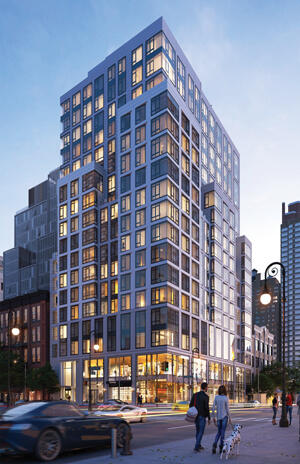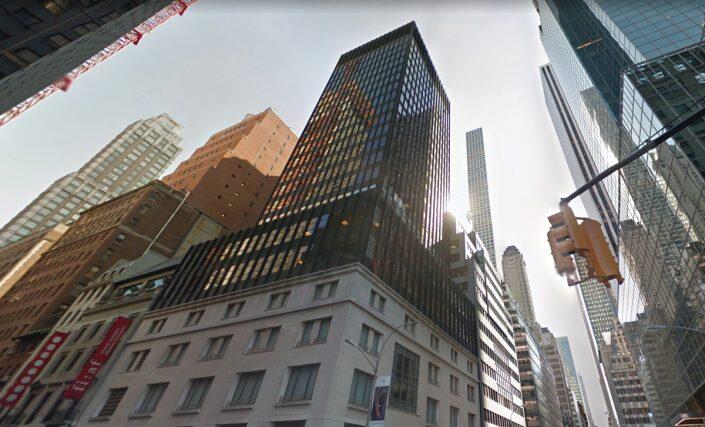After six years and more than $70 million, Nightingale and Friedland just gave up: They handed over the keys.
The 22-story tower at 645 Madison Avenue was a trophy for both firms. The building was Nightingale’s first Manhattan project and added 164,000 square feet to Larry Friedland’s Madison Avenue empire.
Friedland and Nightingale, along with hedge-fund billionaire Bill Ackman, bought the leasehold at 645 Madison for $76 million in October 2015. At the same time, Pasadena-based East West Bank took over the $45 million leasehold mortgage from Bank of America. They issued another $5 million mortgage that November, but in 2019, Nightingale and Friedland moved to book a quick profit and put the building up for sale.
Buyers, however, balked at the reported $120 million asking price, and the pandemic’s drag on commercial assets didn’t help. By September, saddled with hefty interest payments and staring at the most uncertain market in decades, the owners had had enough.
“I gather that the borrower said, ‘We’re not going to keep paying the debt service, we’re underwater,’” said Eric Schoenfeld, who co-chairs Tannenbaum Helpern’s real estate practice.
“Sometimes the best option is to just give up the asset and walk away,” said Adi Chugh, founder of finance brokerage Surya Capital Partners.
Friedland and Nightingale resorted to a leasehold transfer, just one of many creative agreements commercial lenders and borrowers have had to strike during the pandemic. As nonperformance spiked, but foreclosures remained both legally barred and optically frowned upon, commercial lenders have had to either extend unprecedented rope or get creative to maintain leverage with troubled borrowers.
“At the moment, banks are using a very light hand with respect to their troubled borrowers, because it’s more of a perception issue,” said Garry Graber, a commercial litigator at Hodgson Russ. “They don’t want to create the perception that they’re kicking somebody who’s down and out through no fault of their own.”
Other times, a building wasn’t so much given away as wrested.
Even the stodgiest bookworms would fall asleep reading Article Nine of the Uniform Commercial Code. But, if you pry their heads up and unstick the pages from their faces, you’ll find one neat trick that allows lenders to take over assets, even during the pandemic’s commercial foreclosure moratorium.
Think of the UCC as a template for how states regulate commerce: It sets common laws and expectations between the states so companies can, for example, build their widgets in Arkansas, store them in Kansas and sell them in New York.

The Hayworth at 1289
Lexington Avenue
Article Nine maps out a system whereby creditors can get foreclosable liens on their debtors’ personal property. Under it, if Cain lends Abel $1,000 to buy a lawn mower, but Abel can’t pay Cain back, Abel doesn’t have to start wearing a helmet; Cain has the right to sell Abel’s lawn mower to recover his principle.
In New York, the foreclosure moratoriums haven’t applied to so-called “personal property” foreclosures. So while a lender couldn’t foreclose on a debtor’s building, it could foreclose on the debtor’s ownership shares in a building. Which is where it gets interesting for real estate.
Senior lenders don’t usually receive personal shares in a property as collateral from their borrowers. But mezzanine lenders do, so they tend to be the ones that engineer UCC foreclosures.
Take the Hayworth, the Upper East Side tower that Ceruzzi Properties began assembling in 2013, at the height of the condo boom. The building, at 1289 Lexington Avenue, had almost everything, with a verdant roof deck, an “imagination room” designed by early-childhood experts and elegant floor plans. It only lacked buyers.
By the time the Hayworth launched sales in 2019, a glut of luxury condos was dragging down the Manhattan market. In order to build the 61-unit tower, Ceruzzi took a $155 million construction loan from the British hedge fund Children’s Investment Fund, a prolific — and reportedly expensive — lender that has bankrolled HFZ Capital Group’s the XI and Macklowe Properties and CIM Group’s 432 Park Avenue.
Records from Children’s recent lawsuit against Ceruzzi show that the developer pledged 100 percent of the equity interest of Monty Two East 86th Street Associates LLC, the shell company it used to purchase the plot in 2013, as collateral for a mezzanine loan from Children’s. In other words, Ceruzzi pledged its ownership equity in the project, not the building itself.
From March through September 2020, Ceruzzi failed to make full interest payments, racking up more than $15.4 million in fees and payment shortfalls and triggering a default on the mezzanine loan, according to an affidavit by Hal Livingstone, a partner at Children’s.
This October, The Real Deal reported that Children’s was foreclosing on that equity interest, selling Ceruzzi’s stake in the firm to recover its principle. The UCC personal property foreclosure was a way around the strict legal measures intended to prevent foreclosures.
“Why they didn’t put a moratorium on personal property foreclosures, I don’t know,” said Graber.
UCC ya later
Amid explosive lawsuits and investigations by the state attorney general, Ziel Feldman’s HFZ has lost its grip on hundreds of millions of dollars’ worth of condo product, thanks to the UCC foreclosure.
In January, CIM sold ownership interests in four HFZ condos: 88 and 90 Lexington Avenue, the Astor on the Upper West Side and Fifty Third and Eighth at 301 West 53rd Street.
HFZ cross-collateralized its junior mezzanine loans from CIM, so that a foreclosure sale on one would carry the ownership shares of all four. HFZ also cross-defaulted the properties, so that if one tanked, they all would.
Because CIM was not the senior lender, it accepted pledges of equity interest in the buildings’ ownership LLCs, rather than the buildings themselves, as collateral. That proved critical.

As it was owed ownership shares rather than property, CIM was allowed to foreclose: It was not violating the state moratorium. CIM still had to purchase the shares at auction, as UCC foreclosures require an auction sale of the equity interest, but it was able to make a credit bid against the $90 million in outstanding principal it was still owed. Any other suitors would have the deck stacked against them.
Though it was a stunning coup for CIM, the process highlighted one danger of going the UCC foreclosure route. According to the auction materials, HFZ still owed over $100 million on senior loans on the four condos. CIM had essentially become the ownership LLC, so now it owed the senior lender that money. For that reason, UCC foreclosures tend to favor lenders who are savvy about development and can see a project through.
Wiped out
For some developers, UCC foreclosures haven’t just resulted in them losing a building — they’ve tanked their whole business.
According to a recent lawsuit, Madison Realty Capital has foreclosed on Hello Living’s 1580 Nostrand Avenue, leaving developer Eli Karp and his firm running on fumes.
“I have lost everything,” Karp said in October. “I can’t get around how this happened.”
Here’s how. In 2018, Madison bought the loans on three of Karp’s Brooklyn developments: 1520 Fulton Street, 271 Lenox Road and 1357 Flatbush Avenue. Court records show Karp then took out a series of mezzanine loans, planning to use one to buy out his partners and another to refinance the Fulton and Lenox projects. Like HFZ, Karp aimed to cross-collateralize the properties, and pledged his ownership shares as collateral for the loan to take control from his partners.
Then, in June 2019, Madison, led by Josh Zegen, Adam Tantleff and Brian Shatz, bought the senior loan on a different Karp project at 1580 Nostrand Avenue. The following February, Madison declared the loan in default, saying Karp had missed his interest payment for July 2019 and every month thereafter. Madison tacked on interest at the 24 percent default rate, accruing daily from that date.
At first, it appeared that Madison had given Karp some rope. The two entered a forbearance agreement in August 2020, court records show, which gave Karp until March 2021 to get back on track with payments on his East Flatbush project. But if the devil’s in the details, the agreement had plenty of demons.
For one, it included a clause that the loan could be advanced, and due in full, if Karp missed another payment. And critically, the forbearance agreement included a $2 million mezzanine loan, secured by ownership equity, that was, in effect, an advance against the interest that Karp had already accrued. If Karp failed to pay back the loan by March, Madison could commence a UCC foreclosure sale on Karp’s stake in the project.

645 Madison Avenue (Google Maps)
With more than $46 million in outstanding mortgage loans and fees on the project, and pressure mounting on the other three developments, Karp had little choice but to accept. In the lawsuit, he alleges that Madison placed him in a high-wire act.
When the mezz loan matured in March, Karp hadn’t repaid it or the initial loan in full. Madison filed to foreclose, and despite initial pushback, won judicial approval to auction off Karp’s ownership shares in December.
“It is simply an exercise of a lender’s contractual rights,” Madison’s lawyers said in court papers.
Long-term games
There has not been anything close to the UCC foreclosure cliff some in the industry foretold at the height of the pandemic. But they presented one way out, particularly for lenders looking to maintain relationships.
“[Lenders’] business is not based on one cycle, it’s based on their reputation for decades,” Chugh said. By avoiding tarring their borrowers’ reputations now, a lender can keep the door open to future deals.
Traditional foreclosures are costly, time-consuming, and can have long-term repercussions for borrowers and lenders. But because a UCC foreclosure happens outside the purview of the courts, it more resembles a deed-in-lieu agreement than a traditional foreclosure. There are few of the associated costs of going to court, and it doesn’t leave the same stain on credit.
“It’s a much more efficient system than our real property system,” said Graber.
Other lenders say if they have given their borrowers rope for this long, they might as well stick it out for the rest of the pandemic. But that’s not to say things are lax: Lenders will take whatever option will lose them the least money, said one loan workout expert. And if that means taking over a building, so be it.
“Lenders aren’t scared,” said Chugh. “Lenders will take over whatever they have to.”
Upon grabbing the ownership LLC, mezz lenders are still responsible for the senior loan payments. It’s as if they have stepped into their borrowers’ shoes, not just taken their lunch money. It’s one reason the arrangement can be less than ideal for a firm that is in the business of lending, not property development.
“The reality is, in this market, it’s been more about the lender getting what they can,” said Tannenbaum Helpern’s Schoenfeld. “A lot of these lenders don’t want bad debt on their books.”
Given how much money is floating in the market, Chugh said, ”if assets are in trouble, most assets have an exit.”
And as the pandemic has hurt even the big fish in New York real estate, some lenders have had to face the tough choice of going after bigwigs or getting out altogether. Many opt to bring in a distressed debt firm to handle it.
This has opened the door for a different class of lenders who relish the chance to play hardball. Distress specialists such as Maverick Real Estate Partners, who move to foreclose on the loans as soon as one day after purchasing them, function as a trash compactor for debts that banks don’t see improving and no longer want.
“If they don’t want to get their hands dirty,” said Chugh, “they just end up selling the note to somebody else.”
